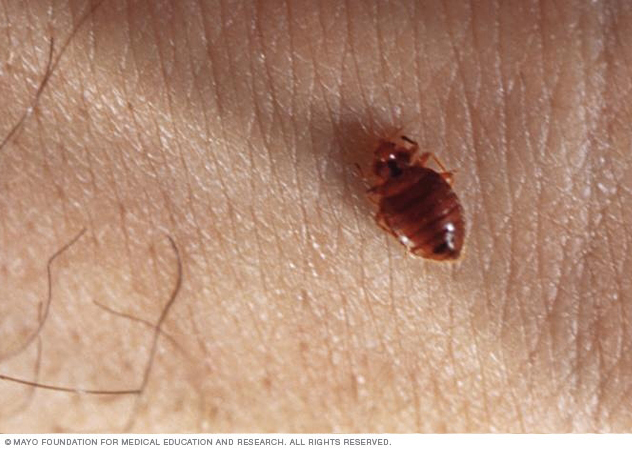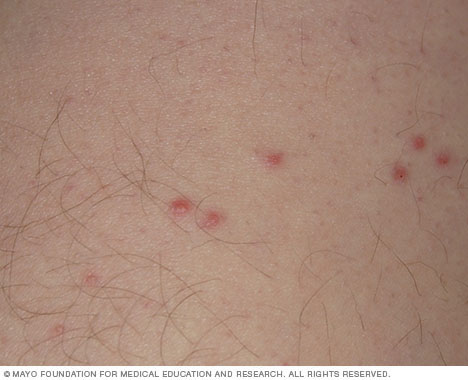Overview
Bedbugs are small, reddish-brown blood-sucking, wingless insects. Bedbug bites usually clear up without treatment in a week or two. Bedbugs aren't known to spread disease, but they can cause an allergic reaction or a severe skin reaction in some people.
Bedbugs are about the size of an apple seed. They hide in the cracks and crevices of beds, box springs, headboards, bed frames and other objects around a bed and come out at night to feed on their preferred host, humans. The risk of running into bedbugs is higher if you spend time in places where nighttime guests come and go often — such as hotels, hospitals or homeless shelters.
If you have bedbugs in your home, professional extermination is recommended.

Symptoms
Symptoms of bedbug bites are similar to symptoms of other insect bites and rashes. Bedbug bites are usually:
- Inflamed spots, often with a darker spot in the middle
- Itchy
- Arranged in a rough line or in a cluster
- Located on the face, neck, arms and hands
Some people have no reaction to bedbug bites, while others experience an allergic reaction that can include severe itching, blisters or hives.
When to see a doctor
If you experience allergic reactions or severe skin reactions to bedbug bites, see your health care provider for professional treatment.

Causes
Bedbug infestations may be linked to:
- More frequent travel
- Changes in pest control practices
- Insecticide resistance
Where do they hide?
Bedbug infestations usually occur around or near where people sleep. They can be found in:
- Clothing
- Luggage
- Bedding
- Boxes
- Box springs
- Mattresses
- Headboards
- Objects near beds
They can also be found:
- Under peeling paint and loose wallpaper
- Under carpeting near baseboards
- In upholstered furniture seams
- Under light switch plates or electrical outlets
How do they spread?
Bedbugs can move from one site to another by traveling on items such as clothing, luggage, furniture, boxes and bedding.
Bedbugs can easily travel between floors and rooms in hotels or apartment buildings.
Sign of uncleanliness?
Bedbugs don't care if their environment is clean or dirty. All they need is a warm host and plenty of hiding places.
Risk factors
You're at risk of bites from bedbugs if you're in places where people come and go often, such as apartment buildings, dorm rooms, homeless shelters, hotels, cruise ships, trains, buses and refugee camps.
Prevention
- Cover up. Bedbugs don't tend to burrow under clothing. So you may be able to avoid bites by wearing pajamas that cover as much skin as possible.
- Inspect secondhand items. Look over used bedding, mattresses and upholstered furniture before bringing them into your home.
- Use hotel precautions. Check mattress seams for bedbug excrement and place your luggage on tables or dressers instead of on the floor.
Diagnosis
If you suspect that you're being bitten by bedbugs, immediately inspect your home for the insects. Thoroughly examine crevices in walls, mattresses and furniture. You may need to perform your inspection at night when bedbugs are active.
Look for these signs:
- Dark specks. Typically found along mattress seams, these specks are bedbug excrement.
- Skin castings. Bedbugs molt five times before becoming adults. These empty skins are pale yellow.
- Rusty or reddish stains. You may find small smears of blood on your bed sheets where bedbugs were crushed.
Treatment
Bedbug bites don't usually need treatment, as they usually disappear on their own within a week or two. You might ease symptoms by using:
- A skin cream containing hydrocortisone (Cortaid)
- An oral antihistamine, such as diphenhydramine (Benadryl)
Treating your home
It can be difficult to get rid of a bedbug infestation because they hide well and can live months without eating. You may need to hire a professional exterminator, who will likely use a combination of pesticides and nonchemical treatments.
You may also treat your home for bedbugs by:
- Vacuuming. A thorough vacuuming of crevices can remove bedbugs from an area but likely won't capture all of them. Empty the vacuum after each use.
- Laundering. Washing items in water that's at least 120 F (48.9 C) can kill bedbugs. As will putting them in a dryer on a high setting for 20 minutes.
- Placing items in an enclosed vehicle. If you live in a very hot place, bag up the infested items and place them in a car parked in the sun with the windows rolled up for a day. The target temperature is at least 120 F (48.9 C).
In some cases, you may have to throw out heavily infested items such as mattresses or couches. Make it obvious the item is unusable so no one else picks it up and gets bed bugs.
© 1998-2025 Mayo Foundation for Medical Education and Research (MFMER). All rights reserved. Terms of Use


